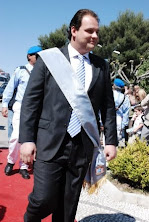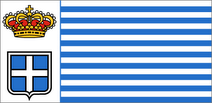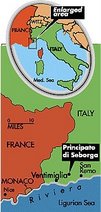In the remote prehistoric period the territory of the Ligurian Piedmont is populated by the Cro-Magnon man; in the Neolithic period, around 5000 years ago, an inhabitant of the place that today is called Seborga carves an idol of stone, while others chip away small stones to make some tools. In that period man has spread also to the islands, from the Balearics to Malta to the Peloponnesus and in all the Mediterranean.
For a millions of years man inhabits this area, this Ligurian Provenza, gifted with a fortunate climate that has allowed him to prevail over glacial periods. A Ligurian population, always settled in our mountains, made of rough, strong and patient men who, incredibly, love these stones, this barren and poor land.
Towards the end of the Bronze Age, 1250 - 1300 B.C., one small tribe, belonging to the Celtic world and coming from the Euro-Asian east, crosses the barrier of the Maritime Alps, comes down along the divide that from the Marguareis mountain descends to the sea at Bordighera and occupies the west side of the mountain.
In the mountains, and always on the western side, some important people are buried in large tombs. Among them, one burial ground gives this place the name of Seborga. The occupied territory, divided into four villages (today Castelvittorio, Baiardo, Perinaldo and Seborga) is governed by eight men, two from each village, who then elect a leader.
The eight faithful and their descendants settle in these places and near the main tomb: they guard it, they defend it and they make it a reason for living for thousands of years and more.
This tradition, of eight plus one, will continue for thousands of years to come, until the time of the establishment of the rules of the “Paupera Militia Christi” of Saint Bernard and the Order from which its name originates.
With some difficulties, the descendants of the original tribe become part of the Ligurian population and, in part, they adopt the local language and customs, maintaining at the same time their own. One of the words that they accept, typical of the Palaeolithic-Mediterranean language, is the name that is given to the place: Sepulcrum. This name will give the village a prerogative and a sacred role, never to be lost or forgotten.
The ancestors of present day Seborgans do not get involved in the Romano-Ligurian wars, indifferent to the object of the dispute: officially the creation of a coastal road that links Rome with Marseilles, but in practice the subjugation of the Ligurian people to Rome.
At the time of Jesus Christ and the early Christian church, Seborga, with all probability, is directly interested in the absurd issue of the siblings of Jesus. The particular affection that the Jews have for the Ligurian Provenza zone is clearly documented; the Romans themselves confirm this line of contact by exiling to the Rodano valley and the surrounding area the Jews who resist and revolt against Roman domination. With the crucifixion of Christ, begins the Diaspora of Christians to different parts of the world and, of course, in our mountains, where they meet the descendants of the Celtic tribes.
The two religions have great and fundamental points in common, among them the oneness of God; the immortality of the soul; an intermediate world in which, after the death of the body, the soul is weighed; respect for the saints; the refusal of the sacred representations (the iconoclasm); brotherly love for all; tolerance towards other religious beliefs; and also a particular preference for the sacral meaning of the numbers three and eight.
At this point a mechanism is released, still not clearly understood in its essence but surely linked to the name of the place. The village becomes the “SEPOLCRO” (Sepulchre) for a relic of such importance and sacredness that it cannot be named. From this moment forward, for two thousand years, the place of Seborga becomes sacred: no armies conquer it; no States aspire to it; no Monarchs claim it; and no one even wants to mention it!
With the passing of the centuries this distinctiveness remains unbroken and the reputation of Seborga, always coexisting with the secrecy of its location, is widely known in the Christian world but - it should be said - only at higher levels. The particular relationship between the village and the eastern Provenza continues and we see a period characterised by invasions, destruction and pillage; Seborga is always protected, nobody touches it.
The involvement of Ludovico the Pious and the formal creation of the Imperial Principality, with the nomination of the bishop Claudius as first Prince, will allow, through the documents and the parchments that survive to us, the writing of a well documented and authenticated history.
The events that follow “the gift” of Guidone confirm its authenticity, in spite of some difficulties in the interpretation of the document. The religious status of Seborga, even if apparently heretical (think of Saint Cassiano and Saint Bernard), is reaffirmed by the arrival of the Catar refugees.
Time moves on and we reach the second half of the 17th Century, with the minting of the coins of the Principality and the incredible story of the “selling” of the Principality by the Savoia Family. Even then the European turmoils do not touch the ancient Principality, which proves to be alien to the earthly disputes and always rightly ignored for its essentially religious status.
And now, in order to finish, the invention of the Reign of Italy, the fall of the monarchy, the short interval of uncertainty and, in 1963, the election of the Prince, H.R.H. George I, reconfirmed (together with the adoption of the General Statutes) 23 of April 1995.
Thus this short summary comes to an end, although some of the mysteries mentioned in this account remain to be explained: what happened to the Seborga documents taken by Genoa; the exact nature of the sacred relic buried, who knows where, in the Principality.
A rich place of ethereal sensations, of indefinite emanations, of that wonderful feeling that makes those who come with a pure mind and honest intentions exclaim: “I have arrived. It’s here that I want to live; this is my world”. A meeting between the greatest: the Empire; and the smallest: the Principality; this incredible place never blemished by wars, conquests, persecutions, earthquakes, armies or conquerors.
All this, and much more than this, is the Principality of Seborga. Respect her; she deserves it; it is her right.
(Translated from “Principato di Seborga: Sintesi Storica di Giorgio Pistone” by R. & E. Colla - September 2006)




